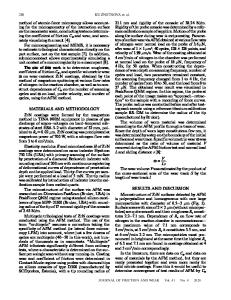Friction and Wear on the Atomic Scale
Friction has long been the subject of research: the empirical da Vinci–Amontons friction laws have been common knowledge for centuries. Macroscopic experiments performed by the school of Bowden and Tabor revealed that macroscopic friction can be related t
- PDF / 80,764,684 Bytes
- 1,529 Pages / 439.37 x 666.142 pts Page_size
- 95 Downloads / 311 Views
Bharat Bhushan Editor
Nanotribology and Nanomechanics An Introduction 2nd edition
123
Professor Bharat Bhushan Ohio Eminent Scholar and The Howard D. Winbigler Professor Director, Nanoprobe Laboratory for Bio- & Nanotechnology and Biomimetics (NLB2 ) 201 W. 19th Avenue Ohio State University Columbus, Ohio 43210-1142 USA [email protected]
ISBN 978-3-540-77607-9
e-ISBN 978-3-540-77608-6
DOI 10.1007/978-3-540-77608-6 Library of Congress Control Number: 2008921404 © 2008 Springer-Verlag Berlin Heidelberg This work is subject to copyright. All rights are reserved, whether the whole or part of the material is concerned, specifically the rights of translation, reprinting, reuse of illustrations, recitation, broadcasting, reproduction on microfilm or in any other way, and storage in data banks. Duplication of this publication or parts thereof is permitted only under the provisions of the German Copyright Law of September 9, 1965, in its current version, and permission for use must always be obtained from Springer. Violations are liable to prosecution under the German Copyright Law. The use of general descriptive names, registered names, trademarks, etc. in this publication does not imply, even in the absence of a specific statement, that such names are exempt from the relevant protective laws and regulations and therefore free for general use. Typesetting and production: le-tex publishing services oHG, Leipzig, Germany Cover design: WMXDesign, Heidelberg, Germany Printed on acid-free paper 987654321 springer.com
Foreword
The invention of the scanning tunneling microscope in 1981 has led to an explosion of a family of instruments called scanning probe microscopes (SPMs). One of the most popular instruments in this family is the atomic force microscope (AFM), which was introduced to the scientific community in 1986. The application of SPMs has penetrated numerous science and engineering fields. Proliferation of SPMs in science and technology labs is similar to optical microscopes fifty years ago. SPMs have even made it into some high school science labs. Evolution of nanotechnology has accelerated the use of SPMs and vice versa. The scientific and industrial applications include quality control in the semiconductor industry and related research, molecular biology and chemistry, medical studies, materials science, and the field of information storage systems. AFMs were developed initially for imaging with atomic or near atomic resolution. After their invention, they were modified for tribological studies. AFMs are now intensively used in this field and have lead to the development of the field of nanotribology. Researchers can image single lubricant molecules and their agglomeration and measure surface topography, adhesion, friction, wear, lubricant film thickness, and mechanical properties all on a micrometer to nanometer scale. SPMs are also used for nanofabrication and nanomachining. Beyond as an analytical instrument, SPMs are being developed as industrial tools such as for data storage. With the advent of more











